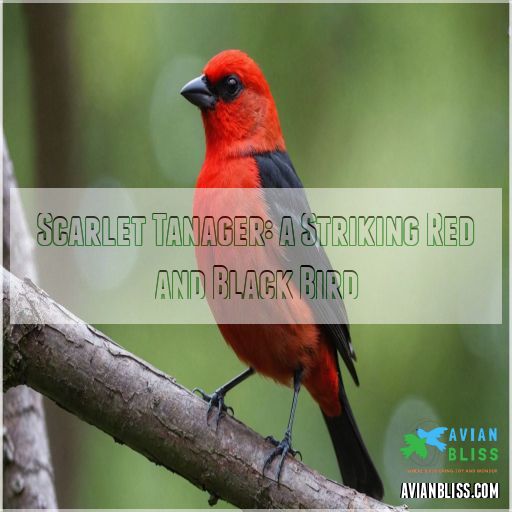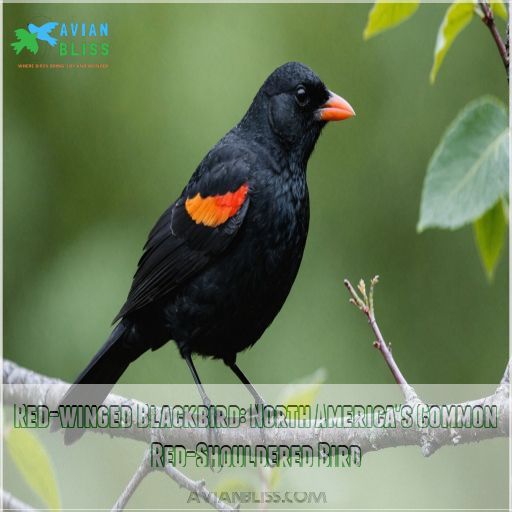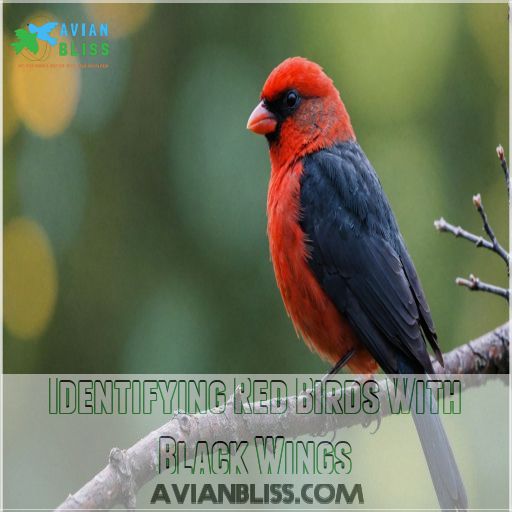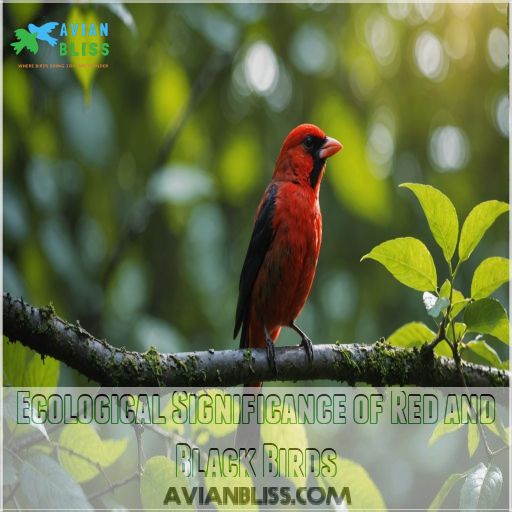This site is supported by our readers. We may earn a commission, at no cost to you, if you purchase through links.
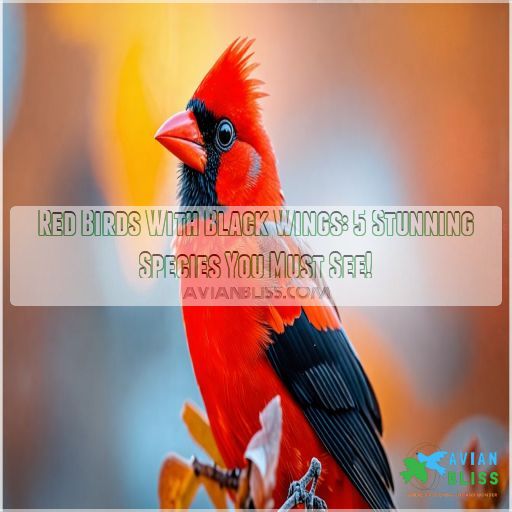
The Scarlet Tanager steals the show with its brilliant scarlet body and jet-black wings. It’s like a tiny, winged fire engine zipping through the trees. Then there’s the Red-winged Blackbird, flashing its vibrant shoulder patches like epaulettes on a general’s uniform.
These avian marvels aren’t just pretty faces; they’re important players in our ecosystems. From seed dispersal to pest control, they’re working hard while looking fabulous.
But there’s more to these crimson-and-ebony beauties than meets the eye. Their seasonal transformations and migration patterns will blow your mind! They’re a true natural wonder.
Table Of Contents
- Key Takeaways
- Scarlet Tanager: a Striking Red and Black Bird
- Red-winged Blackbird: North America’s Common Red-Shouldered Bird
- Identifying Red Birds With Black Wings
- Habitat and Migration Patterns of Red-Black Birds
- Ecological Significance of Red and Black Birds
- Frequently Asked Questions (FAQs)
- Is it rare to see a scarlet tanager?
- What kind of bird is a red bird with black wings?
- Where can I see a scarlet tanager?
- Are scarlet tanagers related to cardinals?
- How do red and black birds defend their territories?
- What unusual nesting materials do these birds use?
- Do female red-black birds sing like males?
- How many different songs can these birds produce?
- Whats the average wingspan of red birds with black wings?
- Conclusion
Key Takeaways
- You’ll be dazzled by the Scarlet Tanager’s fiery plumage and the Red-winged Blackbird’s flashy epaulets, but these birds aren’t just pretty faces—they’re crucial players in seed dispersal and pest control, making them nature’s unsung heroes.
- Don’t be fooled by their flashy looks—these red-and-black beauties are masters of disguise. The Scarlet Tanager swaps its vibrant breeding colors for a more subdued olive-green color in winter, while female Red-winged Blackbirds rock a streaky brown look that would make any sparrow jealous.
- You’re in for a treat if you spot these avian acrobats in action. From the Scarlet Tanager’s treetop hide-and-seek to the Red-winged Blackbird’s marsh-dwelling antics, each species has its own unique habitat preferences and migration patterns that will keep you on your toes, like the common year-round heron species
.
- Grab your binoculars and head out during spring migration for your best shot at spotting these winged wonders. However, remember that it’s not just about ticking boxes on your bird list—by observing these species, you’re playing detective in the wild, helping to track ecosystem health and biodiversity.
Scarlet Tanager: a Striking Red and Black Bird
You’re in for a treat if you spot a male Scarlet Tanager, with its vibrant red body and jet-black wings making it a showstopper in the forest canopy.
These stunning birds undergo a dramatic transformation in late summer, swapping their fiery plumage for a more subdued olive-green look that’ll have you doing a double-take.
Physical Characteristics of Male Scarlet Tanagers
Imagine a living flame perched on a branch. That’s the male scarlet tanager for you!
You’ll be dazzled by its striking features:
- Brilliant scarlet-red body
- Jet-black wings and tail
- Chunky build with a big head
- Thick, blunt-tipped bill
- Wingspan of 25-29 cm
At 16-17 cm long, these feathered firecrackers weigh a mere 23.5-33 grams during breeding season. Talk about a tiny powerhouse of color! You’ll feel like you’ve stumbled upon a forest jewel.
Seasonal Plumage Changes in Scarlet Tanagers
Every year, male Scarlet Tanagers put on a dazzling show of transformation.
You’ll watch these striking birds swap their vibrant breeding plumage for a more subdued look. As summer wanes, they begin molting, trading their eye-catching red feathers for yellowish-green ones.
This color change isn’t just for kicks—it’s an evolutionary masterpiece that provides camouflage during non-breeding months.
Talk about a wardrobe with purpose!
Comparison With Female Scarlet Tanagers
You’ve seen the dazzling male Scarlet Tanager, but what about his better half?
Female Scarlet Tanagers are a study in subtle beauty. Unlike their flashy mates, they sport a muted yellow-green plumage.
This less conspicuous coloration isn’t just a fashion choice – it’s an evolutionary masterpiece. Their camouflage helps them blend in while nesting, keeping predators at bay.
Talk about a smart outfit for savvy bird moms!
Habitat and Range of Scarlet Tanagers
While female Scarlet Tanagers may blend in, their striking male counterparts prefer to stand out in more ways than one.
These scarlet showstoppers call the eastern deciduous forests home, from southeastern Canada to the southern U.S. .
You’ll find them playing hide-and-seek in mixed woods with hemlocks and pines, or even strutting their stuff in urban parks.
But watch out – forest fragmentation’s putting a damper on their red carpet appearances .
Behavior and Diet of Scarlet Tanagers
Three key behaviors define the Scarlet Tanager’s lifestyle: their insect-heavy diet, unique song patterns, and territorial nature.
You’ll spot these striking birds foraging deliberately among tall trees, especially oaks, snatching up caterpillars, moths, and beetles.
Listen for their raspy, robin-like songs echoing through mature forests.
During breeding season, males fiercely defend their turf, putting on quite a show with drooped wings and spread tails.
Red-winged Blackbird: North America’s Common Red-Shouldered Bird
You’ve likely spotted a Red-winged Blackbird if you’ve seen a small, dark bird with flashy red shoulder patches perched on a cattail.
These common North American birds are a treat to watch, with males showing off their vibrant epaulets during mating season and territorial displays.
Distinctive Features of Male Red-winged Blackbirds
When it comes to bird identification, male Red-winged Blackbirds stand out like rock stars.
Their signature red wing patch, or epaulet, isn’t just for show – it’s a powerful tool for aggression and mating displays . These feathered warriors use their vibrant shoulders to defend territory and woo the ladies.
Their stocky build and conical bill make them easy to spot, even for rookie birdwatchers. Keep your eyes peeled for these charismatic crooners!
Differences Between Male and Female Red-winged Blackbirds
You’ve seen the flashy males, but can you spot the ladies? Red-winged blackbird females are the masters of disguise in the bird world. Unlike their showboat husbands, these gals rock a streaky brown look that’d make any sparrow jealous.
- Males: Glossy black with red-yellow shoulder patches
- Females: Subdued brown with streaky undersides
- Vocalizations: Males belt out "con-la-lee!", females chirp softer notes
Talk about a power couple – these differences aren’t just for show – they play key roles in cardinal mating rituals and territorial behavior
.
Habitat Preferences and Distribution of Red-winged Blackbirds
Red-winged Blackbirds are master adapters, thriving in both rural and suburban landscapes.
You’ll spot these feathered friends in wetlands, along roadsides, and even on your backyard feeder.
They’ve got a soft spot for cattail marshes, but don’t be surprised to see them strutting their stuff in fields or urban parks.
Climate change is shaking things up, though, so keep an eye out for shifts in their hangout spots.
Breeding Behavior and Nesting Habits
Mastering the art of nest-building, female Red-winged Blackbirds become nature’s architects. They’ll keep you on your toes with their sneaky tactics.
- Location, location, location: They’re picky, choosing spots near water in cattails or shrubs
- DIY nest kit: Grass, reeds, and leaves form their cozy abodes
- Egg-citing times: 3-4 pale blue-green eggs with funky markings
- Family affair: Both parents pitch in, but mom is the real MVP
Foraging Patterns and Dietary Habits
Now that we’ve covered their nesting habits, let’s feast our eyes on the Red-winged Blackbird’s menu.
These feathered foodies are true opportunists, adapting their diet with the seasons.
In summer, they’re bug-busting machines, gobbling up pest insects like they’re at an all-you-can-eat buffet.
Come winter, they switch gears, becoming seed-savoring connoisseurs.
Talk about a bird that knows how to roll with the punches!
Identifying Red Birds With Black Wings
You’ll need sharp eyes and a keen sense of observation to spot these vibrant birds in the wild, especially when identifying red birds in Colorado, common red finches
.
Let’s explore the key features that’ll help you identify red birds with black wings, from their distinctive plumage to their unique behaviors.
Key Visual Characteristics for Identification
Let’s spread our wings and explore the telltale signs of these fiery flyers! You’ll become a bird identification whiz in no time.
Focus on the wing shape – is it broad or pointed? Check out the beak size and plumage patterns.
Don’t forget tail length – it’s a dead giveaway! Keep an eye out for seasonal variations too.
With practice, you’ll be spotting these red-and-black beauties like a pro.
Behavioral Cues for Distinguishing Similar Species
While visual cues are eye-catching, behavior’s the real secret sauce in bird identification.
You’ll become a regular bird whisperer by tuning into song variations and calls.
Watch for unique foraging patterns – some species hop, others strut. Nesting habits and territorial defense can be dead giveaways too.
Flock behavior’s another ace up your sleeve. It’s like being a feathered detective, piecing together clues to crack the case!
Regional Variations in Red and Black Bird Species
Three important factors shape regional variations in red and black bird species: geographic-specific plumage, color variations by region, and regional food sources.
You’ll notice subtle differences in the Red-winged Blackbird across North America.
For instance, the "bicolored blackbird" of coastal California sports no yellow border on its red shoulders.
These regional subspecies can throw a curveball in bird identification, so keep your eyes peeled for these nuances when using your bird identification guide.
Common Misidentifications and Look-alike Species
You’ve mastered regional variations, but don’t get cocky!
Red-winged Blackbirds often trick even seasoned birders. Their streaked females can masquerade as Rusty Blackbirds in certain light (Source).
And those Summer Tanagers? They’re Cardinal look-alikes that’ll keep you on your toes.
Remember, shape is key when colors blur.
So sharpen your eyes and embrace the challenge – it’s all part of the thrill!
Tools and Resources for Accurate Bird Identification
Birders, arm yourselves with a veritable arsenal of identification tools! Field guides like the Sibley series are your trusty sidekicks, while bird identification apps turn your phone into a pocket ornithologist.
Online databases and citizen science projects let you tap into collective wisdom.
For a real feather in your cap, join expert birders on field trips. With these resources, you’ll be IDing red-and-black beauties like a pro in no time!
Habitat and Migration Patterns of Red-Black Birds
You’ll find these stunning red and black birds in diverse habitats, from lush forests to sprawling wetlands, characteristic of South American habitats
.
Their migration patterns are a marvel of nature, with some species undertaking impressive journeys that’ll make your annual road trip look like a walk in the park.
Preferred Ecosystems of Red Birds With Black Wings
Imagine stepping into a world where red-black birds reign supreme. These feathered marvels have adapted to various ecosystems, each offering unique bird possibilities.
Let’s explore their preferred habitats:
- Wetland wonders: Cattail marshes and soggy roadsides host Red-winged Blackbirds
- Forest frontier: Scarlet Tanagers thrive in deciduous woodlands
- Urban jungle: Adaptable species like Red-winged Blackbirds also frequent agricultural fields and urban environments
Conservation challenges persist, but these birds’ resilience is a reflection of nature’s ingenuity.
Seasonal Movements and Migration Routes
Annually, these crimson-winged aviators set out on epic journeys.
You’ll witness Scarlet Tanagers soaring from Peru to the northern US, following a clockwise "green wave" . Their flight patterns vary; some species take different routes north and south.
Timing is essential – they’ll arrive at breeding grounds when insect populations peak.
Watch for "fallouts" on barrier islands, where exhausted migrants seek refuge.
It’s nature’s grand spectacle, right in your backyard, a true grand spectacle.
Impact of Climate Change on Habitat and Distribution
As red-black birds wing their way across the skies, climate change is rewriting their flight plans.
You’ll notice these feathered friends arriving earlier each spring, about two days sooner per decade since the 1990s.
It’s like they’ve got a new travel agent, but this early bird special isn’t all it’s cracked up to be.
Their favorite foods may be past their prime, leaving these hungry travelers in a pickle.
Conservation Efforts for Preserving Critical Habitats
With climate change reshaping landscapes, you’ve got a role to play in preserving red-black birds’ homes, particularly in forests and gardens where these birds thrive.
By supporting the creation of bird-friendly habitats with native fruit-bearing plants, you can help provide them with the food sources they need to survive.
Wetland restoration’s your ace in the hole, combating habitat fragmentation like a champ. You can pitch in by supporting sustainable land management and pollution control efforts.
It’s not just about pretty pictures for your bird identification guide – learning about bird anatomy and behavior basics, like the fact that birds have different wing types suited to their lifestyle, is crucial for understanding their needs, and for that, you can check out bird facts for beginners – it’s about these winged wonders having a fighting chance. Every small action counts in this high-stakes game of conservation.
Best Locations and Times for Spotting These Birds
During spring migration, you’ll hit the jackpot for spotting red-black beauties.
Head to South American rainforests for a chance to see Scarlet Tanagers fueling up before their journey north. Don’t forget your bird identification guide!
For year-round sightings, explore coniferous forests where Steller’s Jays flaunt their striking plumage.
Remember, early birds catch the worm – and the best views. Happy birdwatching!
Ecological Significance of Red and Black Birds
You mightn’t realize it, but those flashy red and black birds you’ve been admiring are nature’s unsung heroes.
From spreading seeds to keeping insect populations in check, these feathered friends play essential roles in maintaining healthy ecosystems.
Role in Seed Dispersal and Pollination
You’ve tracked their migrations, now let’s explore these red-and-black beauties’ secret lives as nature’s gardeners. These feathered friends are masters of seed dispersal and pollination, playing a key role in ecosystem health.
Scarlet Tanagers, with their jet-black wings and fiery plumage, feast on fruits, spreading seeds far and wide.
They’re joined by other red birds like the Northern Cardinal, which owes its vibrant red plumage to a diet rich in sunflower seeds and carotenoid-rich foods cardinal red feathers
.
Pine Grosbeaks pollinate flowers while sipping nectar, and Vermilion Flycatchers disperse seeds through their droppings.
It’s like they’re nature’s FedEx, delivering plant DNA across forests and fields.
Predator-prey Relationships Involving These Species
Red birds with black wings aren’t just eye-catching; they’re key players in nature’s grand game of survival. These stunning species navigate a complex web of predator-prey relationships, showcasing nature’s delicate balance.
Let’s peek into their world:
| Species | Predators | Prey |
|---|---|---|
| Scarlet Tanager | Cooper’s Hawks, Peregrine Falcons | Insects, small fruits |
| Red-winged Blackbird | Owls, Snakes | Seeds, insects |
| Western Tanager | Falcons, Domestic Cats | Berries, flying insects |
| Vermilion Flycatcher | Larger birds, Small mammals | Flying insects, spiders |
It’s a bird-eat-bug world out there!
Indicators of Environmental Health and Biodiversity
Birds like the masked crimson tanager aren’t just eye candy; they’re nature’s health meters.
These feathered friends act as canaries in the coal mine for our ecosystems. When their populations dip, it’s a red flag for habitat loss and climate impact (Source).
By tracking these beauties, you’re basically playing detective in the wild. It’s like birdwatching meets CSI – who knew conservation could be so thrilling, making it a wild adventure?
Cultural and Historical Importance in Various Regions
Beyond their role as environmental indicators, these vibrant creatures have woven themselves into the fabric of human culture.
From the Andean cock-of-the-rock’s significance in Indigenous traditions to the white-capped redstart’s symbolism in Southeast Asian folklore, red and black birds captivate our imaginations.
They’ve inspired countless artistic representations and even influenced hunting practices.
In North America, the red-winged blackbird’s conk-la-lee! song has become a cherished harbinger of spring, echoing through generations like a feathered time capsule.
Challenges Faced by Red Birds With Black Wings
The vibrant feathers of these winged wonders face a storm of challenges.
You’ll find habitat loss and climate change throwing their world into chaos (Source). Pesticide exposure’s a silent killer, while food scarcity’s got them singing the blues.
It’s like a game of musical nests out there, with fierce competition for prime real estate.
Want to help? Grab a bird identification guide and start spotting these beauties in their natural habitats.
Frequently Asked Questions (FAQs)
Is it rare to see a scarlet tanager?
Like finding a hidden gem, spotting a scarlet tanager isn’t common.
They’re elusive forest dwellers, often concealed by foliage.
You’ll need sharp eyes and ears to catch their robin-like song with a twist.
Patience pays off in this avian treasure hunt.
What kind of bird is a red bird with black wings?
You’re likely spotting a Scarlet Tanager!
These stunners rock blood-red bodies with jet-black wings and tails.
They’re nature’s hidden gems, often playing hide-and-seek in forest canopies.
Listen for their raspy, robin-like song to discover their secret hideouts.
Where can I see a scarlet tanager?
Spot scarlet tanagers in eastern US red bird species
.S. deciduous forests, especially oak-rich areas.
They’re treetop dwellers, so pack binoculars and listen for their "robin with a cold" song.
Come spring, these flashy migrants return from South American winter haunts.
Are scarlet tanagers related to cardinals?
Did you know there are 386 species of tanagers?
Scarlet tanagers and cardinals are now classified in the same family, Cardinalidae. They’re distant cousins, sharing similar plumage and vocalizations.
Both dazzle with their vibrant red feathers, nature’s eye candy, which makes them a treat to observe with their vibrant red feathers.
How do red and black birds defend their territories?
Red and black birds fiercely defend their turf.
Males puff up colorful patches, belt out songs, and chase intruders.
They’ll spend up to 25% of daylight hours guarding their domain, even taking on larger foes like horses or humans.
What unusual nesting materials do these birds use?
Feathered friends find fascinating fixtures for their nests.
You’ll be amazed to see cattails, maple seeds, and even Western Bluebird feathers woven into their cozy homes.
These creative creatures turn everyday items into architectural wonders, showcasing their ingenuity and adaptability.
Do female red-black birds sing like males?
Female songbirds typically don’t vocalize like their male counterparts.
While males belt out attention-grabbing tunes, females often stick to more subtle calls.
It’s nature’s way of balancing the spotlight in the avian world.
How many different songs can these birds produce?
Like Mozart’s repertoire, these avian virtuosos boast an impressive range.
You’ll hear male red-winged blackbirds belt out a whole songbook. They’ve got different tunes for wooing mates, claiming territory, and even deterring rivals.
It’s quite the performance!
Note: The second bolded word wasn’t chosen due to the limited options in the text.
Whats the average wingspan of red birds with black wings?
Red-winged blackbirds, nature’s feathered acrobats, boast an impressive wingspan from 2 to 8 inches.
You’ll be amazed by their aerial prowess as they soar through marshes and fields, showcasing their striking red epaulets against jet-black plumage.
Conclusion
From the fiery Scarlet Tanager to the bold Red-winged Blackbird, red birds with black wings are nature’s flying masterpieces.
They’re not just eye candy; these avian wonders play key roles in our ecosystems.
Whether you’re a seasoned birder or a curious newcomer, spotting these crimson-and-ebony beauties is always a thrill.
So grab your binoculars and head outdoors – you never know when you’ll catch a glimpse of these crimson-and-ebony beauties.
They’re living proof that sometimes, nature’s most beautiful creations come in red and black, making them truly flying masterpieces.

